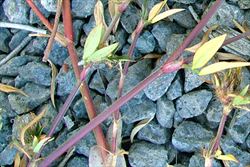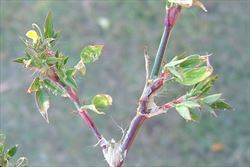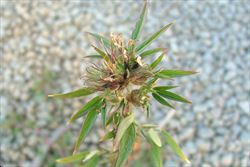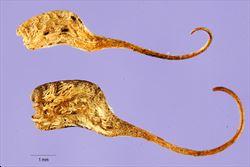Click on images to enlarge

infestation (Photo: Chris Gardiner)

spreading habit (Photo: Sheldon Navie)

finely hairy woody stems (Photo: Sheldon Navie)

stems, leaves and flower cluster (Photo: Sheldon Navie)

elongated leaves with three leaflets and immature fruit (Photo: Sheldon Navie)

close-up of leaves and immature fruit, showing the long bristly hairs on many parts of the plant (Photo: Sheldon Navie)

mature fruit with very long and curled beak (Photo: Sheldon Navie)

close-up of mature fruit with a very long curled beak (Photo: Tracey Slotta at USDA PLANTS Database)
Scientific Name
Stylosanthes humilis Kunth
Family
Fabaceae (Queensland, the ACT, Victoria, Tasmania, and the Northern Territory)Fabaceae: sub-family Faboideae (New South Wales)Leguminosae (South Australia)Papilionaceae (Western Australia)
Common Names
annual stylo, Townsville lucerne, Townsville stylo
Origin
Native to south-western USA (i.e. Arizona), Mexico, Central America (i.e. Belize, Costa Rica, El Salvador, Guatemala, Honduras, Nicaragua and Panama), the Caribbean (i.e. Cuba) and tropical South America (i.e. Venezuela, Brazil, Bolivia and Colombia).
Naturalised Distribution
Widely naturalised in northern Australia (i.e. in northern and north-western Western Australia, in the northern and central parts of the Northern Territory, in many parts of Queensland and in the coastal districts of northern New South Wales). Also naturalised on Christmas Island.
Naturalised overseas in south-eastern Asia and on some Pacific islands (i.e. Fiji and New Caledonia).
Notes
Townsville stylo (Stylosanthes humilis) is regarded as an environmental weed in northern Queensland, the Northern Territory and northern Western Australia.

